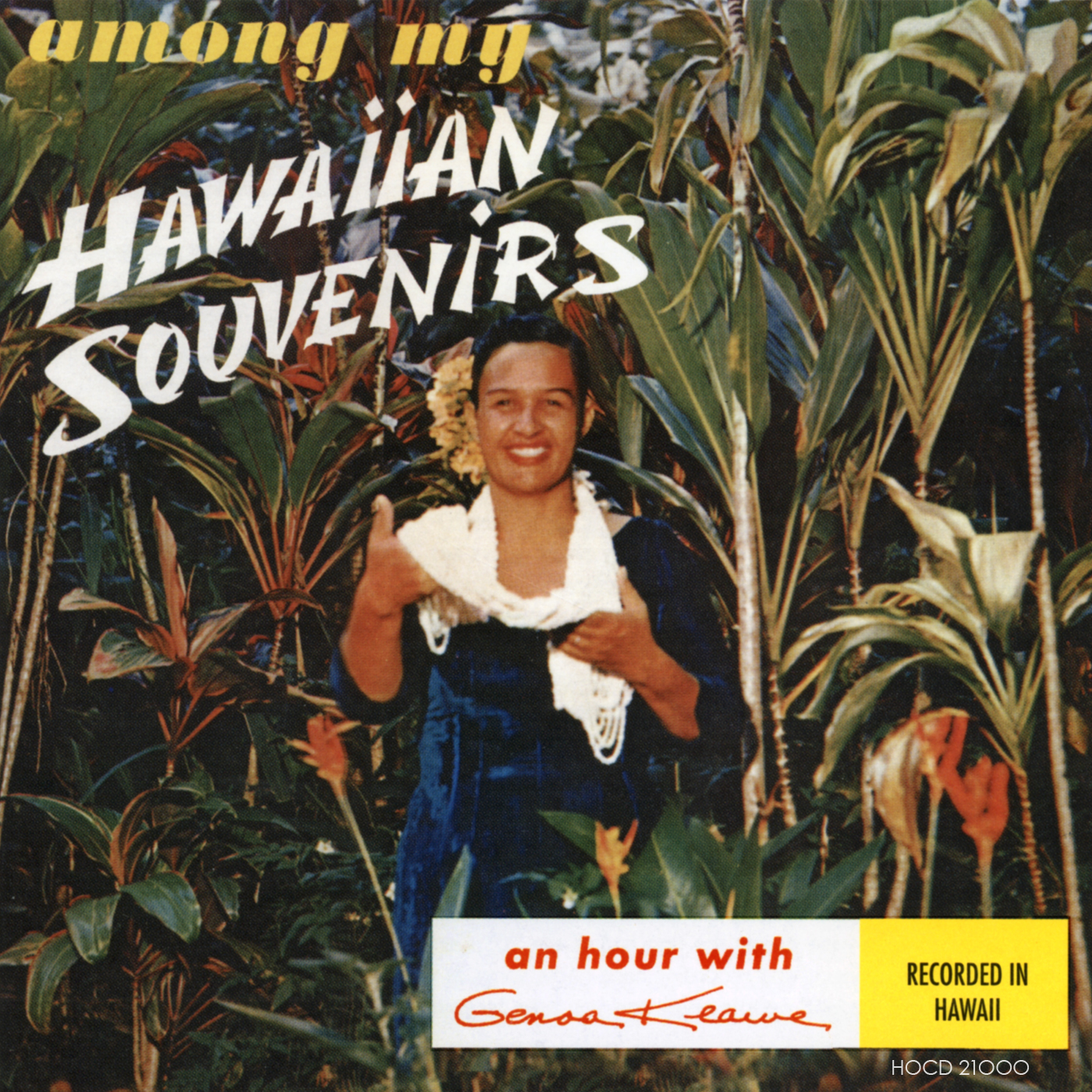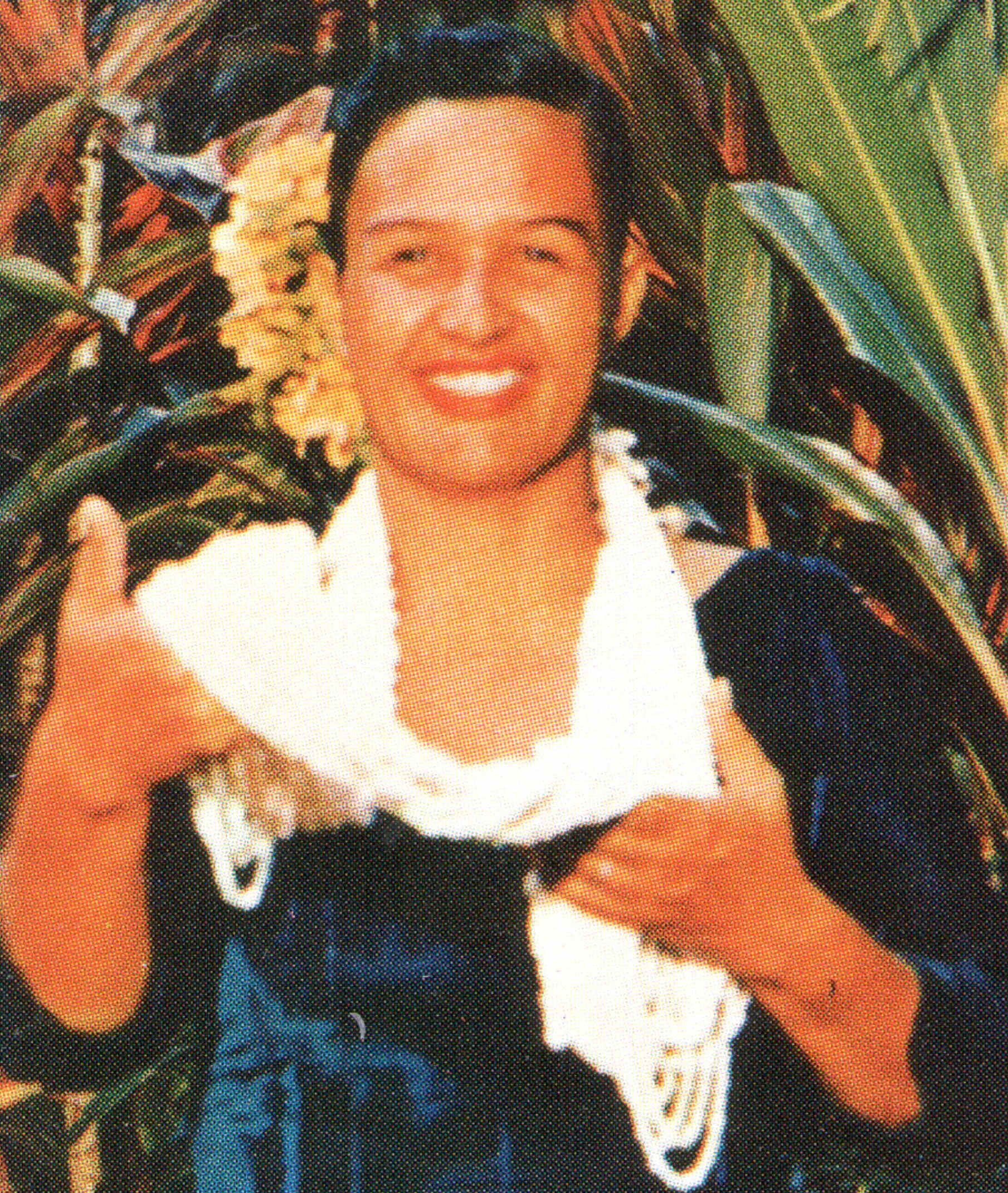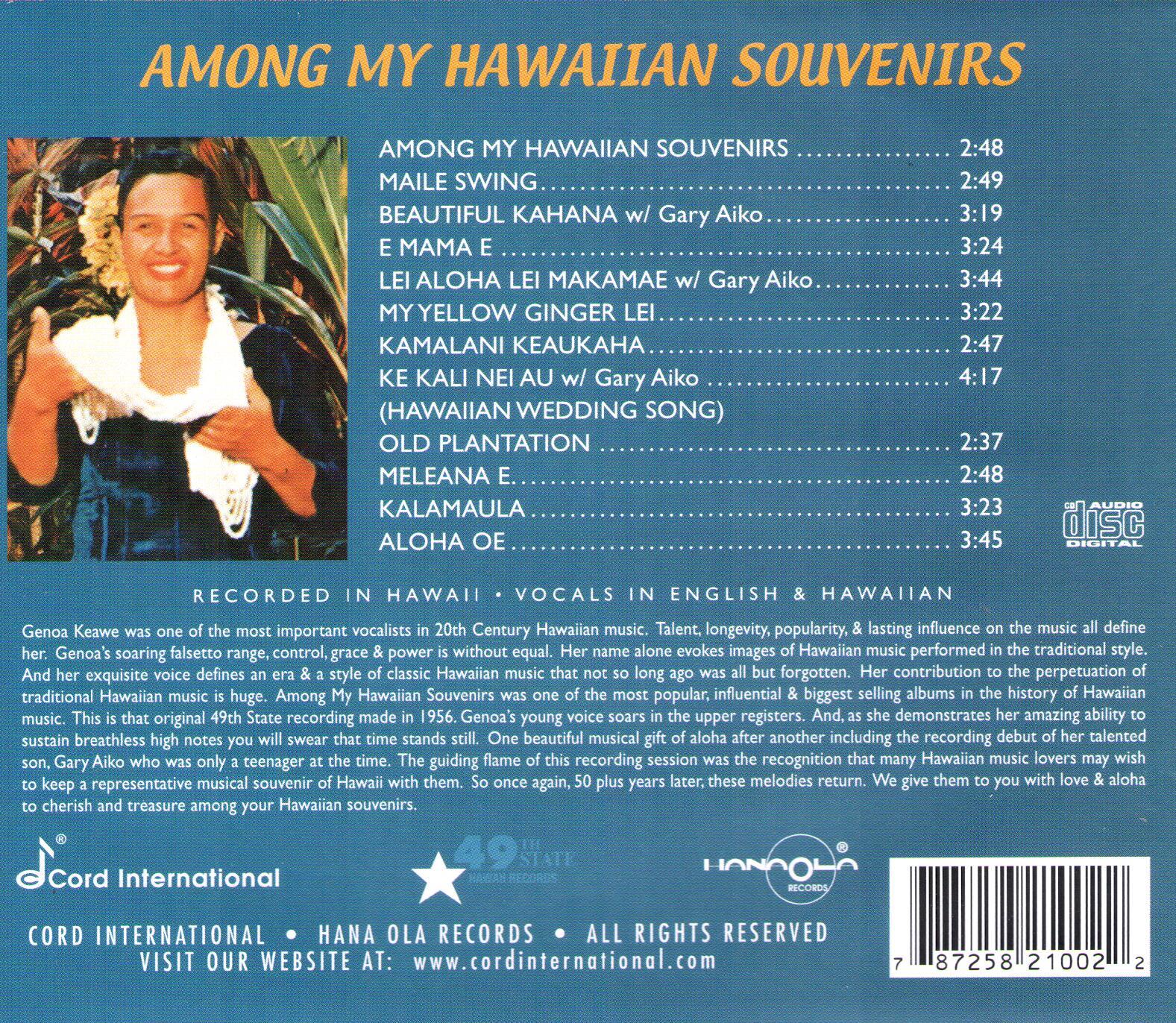

 |
 |
 |
| Download CD NOW | Listen on YouTube | Shipping to USA addresss ONLY |
|
This reissuance of a 1952 LP gives rare insights into why Hawaiian music was such a mellifluous staple among cartoon animators and the street serenaders of the 20s, 30s, and 40s. Genoa Keawe was a falsetto singer and, as liner critic Frank Shaner avers, that isn't something you go to school for. Ya either gots it or ya don't, and Ms. Keawe had it in spades. Though slack key and other South Pacific musics are enjoying a growing popularity, not many are done as authentically as Hawaiian Souvenirs, and it will come as a bit of a shock when the young Gary Aiko duets with the singer on three cuts, giving a surprising glimpse into where Bing Crosby got his crooning basics. |
FAME Review - Folk & Acoustic Music Exchange - Mark S. Tucker |
A Hawaiian Musical Treasure. Genoa Keawe remains a vibrant representative of a musical tradition that in her youth was considered quite modern. That style of social Hawaiian music is sometimes called chalangalang, a Hawaiian pidgin term that suggests the ukulele strumming that accompanies the voice. The yodel effect -- that break between the lower vocal register or “chest voice” and the upper register or “head voice” is called ha’i, which is Hawaiian for “break.” Some call it “female falsetto,” but the term falsetto is usually used to describe the male “head voice” sound. |
FolkWORKS - Audrey Coleman |
No one does reissues of out-of-print Hawaiian records better than Michael Cord's Hana Ola Records organization. Keawe made these recordings in 1956, for instance, but the sound quality is excellent. The liner notes include the original annotation along with five pages of up-to-the-minute background information. Keawe's three duets with her son, Gary Aiko, are exquisite as well. |
Honolulu Star Bulletin - Island Mele - John Berger |
Hawaiian Falsetto singing is a form of musical expression unique to the islands of Hawaii. You can't just go to a falsetto school and be taught these techniques in a music class... you have either been blessed with the voice and the abilities, or you haven't. There is no other style of singing that brings with it such intense tropical passion and raw power. A truly great Hawaiian falsetto singer is able to sustain a lofty note to its outer limits, grab a split second gasp of air, soar to an even higher register, and then dance in that rare air with the utmost control and grace. Passion, romance, control, and power all combine to define the best of the Hawaiian falsetto singers. |
Frank B. Shaner |

Genoa Keawe Among My Hawaiian Souvenirs: 2008 Cord International Hana Ola Records Liner Notes.
Here now firmly in the 21st Century it is natural to look back over the millennium that was the 20th Century and compile lists of the best and brightest and most significant people of the previous 100 years. When it comes to Hawaiian music, Genoa Keawe is unquestionably one of those all-time greats. Her name alone evokes images of Hawaiian music performed in a traditional style. Genoa Keawe inspired several generations of Hawaiian entertainers and more than anyone else kept the tradition of female Hawaiian falsetto singing alive. By whatever criteria you measure her – talent, longevity, popularity, lasting influence on the music – Genoa Keawe was one of the most important vocalists in 20th Century Hawaiian music - a true legend. She made her debut as a recording artist almost 60 years ago. To put that in perspective Territorial Era music historian and record producer Harry B. Soria, Jr. [Soria has produced over 20 Hana Ola Records Anthologies]notes that she recorded in almost every format and configuration used for recording during the past century: acetate, tape, and digital recording equipment have all captured performances that were released on large 78-rpm shellac platters, on “unbreakable” 45-rpm and 33-rpm vinyl albums, 4-track and 8-track cartridges, cassettes, and most recently on compact discs. Improved digital recording equipment and computer audio restoration technologies make it possible to enjoy Genoa’s earliest recordings today. Fans and music scholars alike often call her musical style “cha-lang-alang”. Keawe disliked the term preferring to describe it as “Traditional Hawaiian”. By either name it is a homegrown backyard style of Hawaiian folk music that is often more up-tempo than the familiar hapa-haole style popularized world-wide during the first half of the 20th Century. Genoa however enjoyed singing and recording hapa-haole songs as well. “Music is the spice of life, the kind people enjoy, and you have to enjoy it with them,” she explained. Genoa also contributed to the perpetuation of Hawaiian music as a recording artist, a “live” club and concert performer, and as the head of her own record label. She performed across Hawaii, the American mainland, Japan, Singapore, New Zealand, Tonga, Russia, Switzerland, Canada, Brazil and elsewhere. She continued to perform well into her 80s - an age when most artists would have long since been forced into retirement by failing health or fading talent. Genoa never missed a beat delighting Hawaii residents and visitors alike. Her rendition of "Meleana E" which she sand with such impeccable breath control seeming to hold the notes forever was always a showstopper. Keawe was born in the Kaka’ako district of Honolulu Genoa Leilani Adolpho on October 31st, 1918. Much of the area back then was still pasture and scrubland. Her father died young and some of her 10 siblings were farmed out to relatives to ease the burden on her mother. The family was later reunited, but Genoa left home for good at age 16 when she married Edward Punawai Keawe-Aiko in 1935. The couple had 12 children – 4 girls and 8 boys. As in many traditional Hawaiian families Genoa's mother-in-law and other relatives helped her with the children. She said that her parents “weren’t singers” so that she learned to sing in church. She fell in love with Hawaiian music, and credits her learning of the Hawaiian language to her mother-in-law who spoke no English. She inspired her towards becoming fluent in Hawaiian. "Every time I would be sitting down at the table in the morning, the two of them would be talking in Hawaiian," she said in 2007 shortly before celebrating her 89th birthday. Keawe always encouraged the young up and coming singers that she generously mentored to learn Hawaiian so they could pay due respect to the song writers' words. She also felt that understanding Hawaiian made it possible for her to understand the intricate nuances of the Hawaiian song and the more subtle kaona or hidden meaning. She was a native speaker of Hawaiian (the current term for someone who learned Hawaiian from kupuna: a grandparent, ancestor, relative, or close friend of the grandparent’s generation -or- from ohana: family, relatives, or kin group – rather than through formal instruction in school. She said that she sometimes would have trouble understanding people who speak Hawaiian rapidly, but her friends said that she modestly downplayed her own knowledge and fluency. Genoa was singing professionally while still a teenager before World War II. She said that her cousin, Andy Cummings [Andy Cummings & His Hawaiian Serenaders HOCD 65000] was one of the several singers who inspired and influenced her when she was starting out. Alice Namakelua, Alice Johnson, Bill Lincoln [Bill Ali'iloa Lincoln Hawaii's Falsetto Poet HOCD 98000], Lena Machado [Lena Machado Hawaiian Song Bird HOCD 29000], and John Kameaaloha Almeida [John Kameaaloha Almeida The Dean of Hawaiian Music 1897-1985 HOCD 49000] are some of the others who fueled her interest in Hawaiian music. In 1946, Genoa listened to the popular live radio broadcasts of John Kameaaloha Almeida on KULA Radio. On one particular broadcast, John issued an invitation to any talented entertainer to join him on the air. Genoa rushed to the station then located on Kapiolani Boulevard in Honolulu, and sang with him. That was her debut radio performance and the beginning of a very special relationship. Genoa’s very first singing job was at a place called Roll Inn. She recalled it only lasted a few months “because we didn’t sound so good". She began appearing on Kailua bandstand shows and in military clubs on Oahu. “Among My Hawaiian Souvenirs” became one of her favorite songs after she heard Emma Veary sing it at Honolulu Hale. An engagement at Club Polynesia got her career rolling for real. At first her husband wasn't sure whether or not it was appropriate for his wife to be performing in bars and nightclubs so she used the shortened version of her last name Keawe. She said her husband eventually began to regret telling her that he didn’t want her to use her married name on stage. She kept the shortened version of her name for the rest of her life. (Edward Keawe-Aiko died in 1985, the year they would have celebrated their 50th wedding anniversary.) The end of World War II brought new opportunities to Hawaii. Local people suddenly had plenty of money to spend, and Honolulu businessman George K. Ching decided to begin recording Hawaiian music on a new record label. Ching named his label 49th State Hawaii Records – a name that reflected the widespread belief that Hawaii was overdue for statehood. No one realized then that Alaska would actually become the 49th state, and Hawaii would end up as the 50th. Ching knew there was a desire for new recordings by Hawaiian artists, and he owned a record store to sell them in, but he was interested in more than a quick buck. He also wanted his recordings to be authentic and so he retained John K. Almeida as his musical director. Almeida was already known as a major figure in what was then considered modern Hawaiian music. Today Almeida is lovingly referred to as the “Dean of Hawaiian Music”. When Genoa was signed to 49th State Hawaii Records she became his protégé. The first song she ever recorded, “Maile Swing”, was an Almeida composition that featured Almeida and his musicians as her studio band. Genoa recalled how Johnny corrected her pronunciation of one particular word in his composition when she was rehearsing the song. She was informed that she had just said a naughty word, and was immediately taught the correct pronunciation. “I never made that mistake again!”she giggled. Other early 49th State Hawaii Records recordings featured her own group, Genoa Keawe & Her Hula Maids. She and her group also recorded duets with Almeida and with George Naope. George Naope later went on to be a famous hula instructor and the originator of the “Merry Monarch” big hula festival in Hilo. “49th State was a special company – all Hawaiian artists – authentic”, said Genoa. When she first started it was all work for hire, and she was paid $3.00 per night. Eventually her fee went up to $6.00 and then $7.00 per night. “This was before statehood and that was a lot of money back then.” They would have their recording sessions at the home of George K. Ching. “One-hundred plus steps up to his house in Manoa Valley – way up on a hill.” “So many memories – so much nostalgia”, Genoa remembered fondly. Genoa’s voice was distinctive even then. Her rendition of “E Mama E”, a song written in the 1920’s as a showcase for Hawaiian falsetto singers, was a marvelous display of her vocal range and breath control. It was almost a generation later that two friends provided the capital to help launch Genoa Keawe Records. GKR released a series of now-classic traditional Hawaiian albums that featured Vickie Ii Rodrigues, Pauline Kekahuna [Pauline Kekahuna and Her Hau'oli Girls 1953 - 1955 HOCD 2085], Joe Custino, Violet Pahu Lilikoi, Billy Gonsalves [Billy Gonsalves and His Paradise Serenaders HOCD 38000] and Herbert Hanawahine, as well as Genoa and her sons, Gary and Sam. Many of her songs became mainstays of the Hawaiian music repertoire. Hawaiian ethnomusicologist Amy K. Stillman [Producer of Hana Ola Records Ancient Hula Hawaiian Style Hula Kuahu Anthology HOCD 2010] described Keawe's importance to Hawaiian music. "In addition to her unrivalled falsetto technique, bell-like yodelling, and her trademark ability to hold high notes for over two minutes. Genoa Keawe was particularly significant for her focus on presenting repertoire for modern hula, i.e., hula performed to westernized melodies and the accompaniment of western instruments such as guitar and ukulele. She operated a hula studio in Pauoa for many years, and served as a resource for scores of Hawaiian musicians throughout a career that spanned over 60 years." Harry B. Soria, Jr. said of Keawe, "During the past few decades, whenever I had the privilege of emceeing a show and Aunty Genoa was in the house, I just had to announce to the crowd that Genoa Keawe was in the building, and the crowd would give her a roar and a standing ovation. She was truly a Hawaiian music icon, because she embodied all the qualities of your favorite Aunty, and by the way she could give you 'chicken skin' every time she began to sing with ha'i." Many honors, too numerous to mention all off them, have been bestowed upon her by a grateful Hawaii including multiple Na Hoku Hanohano Awards from the Hawaii Academy of Recording Arts, a Ho'okahiko Award reserved for those who have made it their life quest to exemplify the cultural values and traditions of Hawaii, and the National Endowment for the Arts National Heritage Award honoring American folk artists for their contributions to our national cultural mosaic. In 2000 she was inducted into the Hawaiian Music Hall of Fame. In 2005 the University of Hawaii presented her with an honorary degree for her contribution to Hawaiian music. Everyone's favorite Aunty passed away on February 25, 2008 at her home in Papakolea. She was 89. Genoa Keawe may be gone but she will never be forgotten. Now it's time to go back in time and enjoy Genoa singing 12 classic Hawaiian and hapa-haole standards including her debut recording of “Among My Hawaiian Souvenirs”. This is the original “49th State” recording made in 1956. Genoa’s young voice soars into the upper registers on an array of enduring vintage Hawaiian treasures. A reprise of John Almeida’s “Maile Swing” is here, and you can be sure that her pronunciation of the Hawaiian lyric is impeccable. Genoa treats us to one beautiful musical gift of aloha after another, from Kamalani O Keaukaha” to “Kalamaula”. And as she demonstrates her amazing ability to sustain high notes on the breathless “E Mama E”, you will swear that time has indeed stood still. Genoa even shares a pleasant surprise with us – the recording debut of her talented son, Gary Aiko. Only a teenager at the time, Gary is showcased in three memorable duets with his mother – “Beautiful Kahana”, “Lei Aloha Lei Makamae”, and “Kei Kali Nei Au” (the “Hawaiian Wedding Song”). According to Genoa, the guiding flame of this recording session was the recognition that many Hawaiian music lovers may wish to keep a representative musical souvenir of Hawaii with them. So once again, fifty-two years later, these melodies return – we give them to you with love and aloha to cherish & treasure among your Hawaiian souvenirs. |

Genoa Keawe - Among My Hawaiian Souvenirs - HOCD21000
